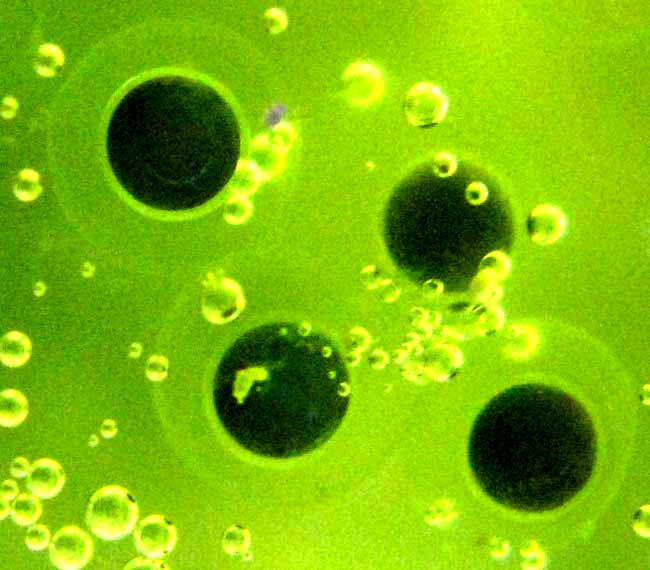Excerpts from Jim Conrad's
Naturalist Newsletter

from the May 23, 2010 Newsletter issued from Hacienda Chichen Resort beside Chichén Itzá Ruins, central Yucatán, MÉXICO
FROG EGGS
Last week I told you about that Saturday's San Isidro fiesta and how the Maya traditionally regard San Isidro as the Rain God, and pray for rain during the church part of the ceremony. Twenty-four hours later our first good rain for weeks fell, and the next evening another couple of inches fell, and for the rest of the week each day there was at least a little to wet thing up.
Frogs went crazy. All night their callings filtered between the poles of my hut's walls, and it was good hearing them. By Monday morning puddles were full of frog eggs. You can see eggs in a garden pool above.
Those eggs -- the four dark spheres -- in real life were only about the size of a stickpin head. The smaller, silvery spheres are air bubbles. The water was full of algae so the bubbles probably are oxygen produced by the algae.
Something interesting about a frog egg is that it's a single big cell -- like a chicken egg, for that matter. A typical frog's egg-cell occupies a volume over 1.6 million times larger than a normal frog cell. Moreover, as the frog embryo develops into a tadpole containing millions of cells, it continues to occupy about the same volume of material. The cells split and split again and again, thousands of times, but the developing organism doesn't increase in size. In the photo you can see how each dark, future tadpole is suspended inside an almost transparent gelatinous mass.
It's also interesting that frog eggs can be identified almost like the frogs that produced them -- characteristics vary from species to species. American Toads lay long strings of eggs while Bullfrogs lay egg masses containing 1000-5000 eggs. I'm guessing that the eggs in the picture were laid by treefrogs because the eggs were so tiny and most eggs floated unattached to others, or with only three or four other eggs, and I've seen treefrog eggs doing that.
The amazing thing about the eggs in this particular pool was their number -- hundreds of thousands of them in a pool the size of a small car. Thousands had splashed onto the pool's concrete walls, where they dried out and were being collected by ants. After that rain we had about a month ago the same thing happened, but then it stopped raining, the pools dried out, and every egg and tadpole in this pool and others died.
If it keeps raining, though, before long we should have lots of tadpoles. I'm going to enjoy watching them develop, and I'll keep you updated.